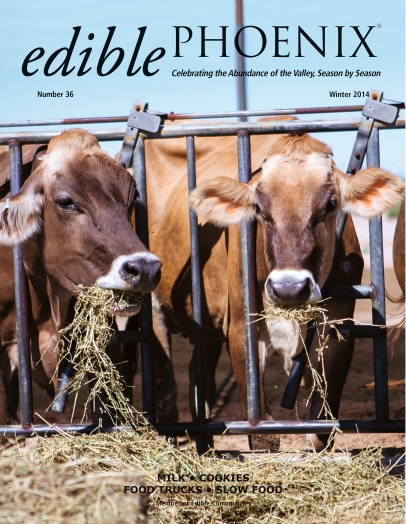Proud Passionate Producers, Letter from the Publisher
Last month was a busy time. It kicked off with the 5th Arizona Farmer+Chef Connection at Desert Botanical Garden in Phoenix, and ended with Slow Food’s huge biennial Salone del Gusto in Turin, Italy and then a local lecture by food activist Vandana Shiva at ASU.
Along the way I bumped into Emma and Jeff Zimmerman and heard the good news that Hayden Flour Mills had received the Martha Stewart award. I also had the great pleasure of attending Les Dames D’Escoffier Phoenix’s Afternoon at the Farm event.
All of these encounters reminded that the only reason I’m able to eat so well and so sustainably is through the efforts of the many hard-working, dedicated producers who grow, raise, process and sell my food. Whether it’s the new suppliers enthusiastically describing their wares at our local Farmer+Chef connection, or the white corn miller who patiently drew out instructions for making polenta to overcome my language barrier in Italy, or Dave from Two Wash Ranch who raises chickens to be the stars of a farm dinner in Phoenix, I’m the lucky beneficiary of these food artisans’ passion.
But as Slow Food founder Carlo Petrini notes, it is not enough to be a consumer, we must think of ourselves as co-producers walking side-by-side with those who supply us with food. If so, what are my responsibilities as a co-producer?
- To ask about the product and the producer
When Vandana Shiva was asked what we could do to make a difference in the face of GMO foods and disappearing seed sovereignty, she responded “know where your food comes from and get to know the person who produces it.” We’ve all heard that before, and my first thought was to dismiss her response and look for a more grandiose solution. But then I thought about it more and realized there is no more profound action to change our food system than to be knowledgeable and care about what we eat, how it was produced and who produced it.
- To treat the food well
Many of the restaurants who attended Farmer+Chef send their staff to local farms to find out what it takes to grow vegetables here in the Valley. They all come back with a renewed appreciation for the produce and a desire to showcase its natural flavors and beauty.
- To cut down on waste
We usually focus our editorial efforts on local authors, but when I read Eugenia Bone’s Kitchen Ecosystem book and heard she was making excerpts available to Edible Communities, I knew that we just had to include her smart, creative suggestions for using every last bit of meat and vegetables in this issue, and to try to follow her example in our everyday cooking.
- To buy the less popular items
Whether it’s the off-cut of meat or the misshapen vegetable or the less popular crops, we have a responsibility to support the producers in everything they need to do in order to farm and ranch sustainably and economically.
- To give thanks
Show appreciation with a handshake at a farmers’ market, or by extoling our favorite local foods to our friends or with a brief moment of reflection and thanks before our next meal or that big holiday dinner.





